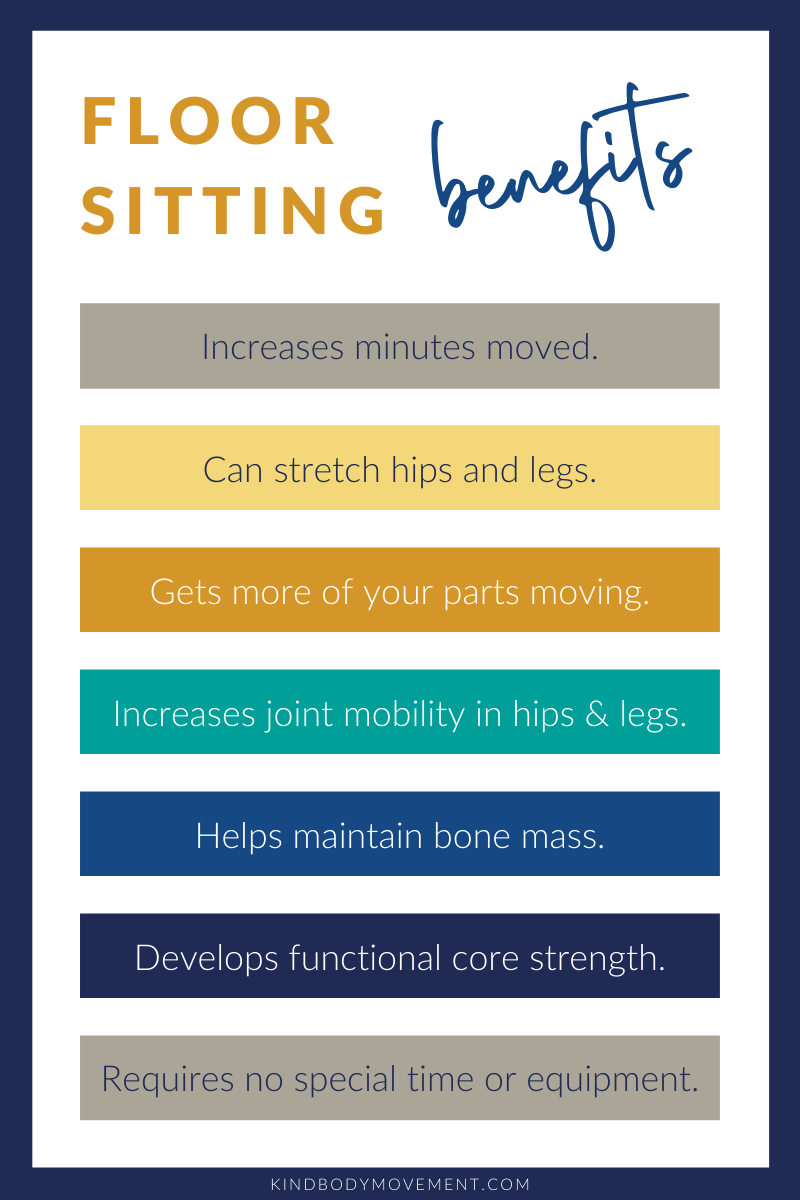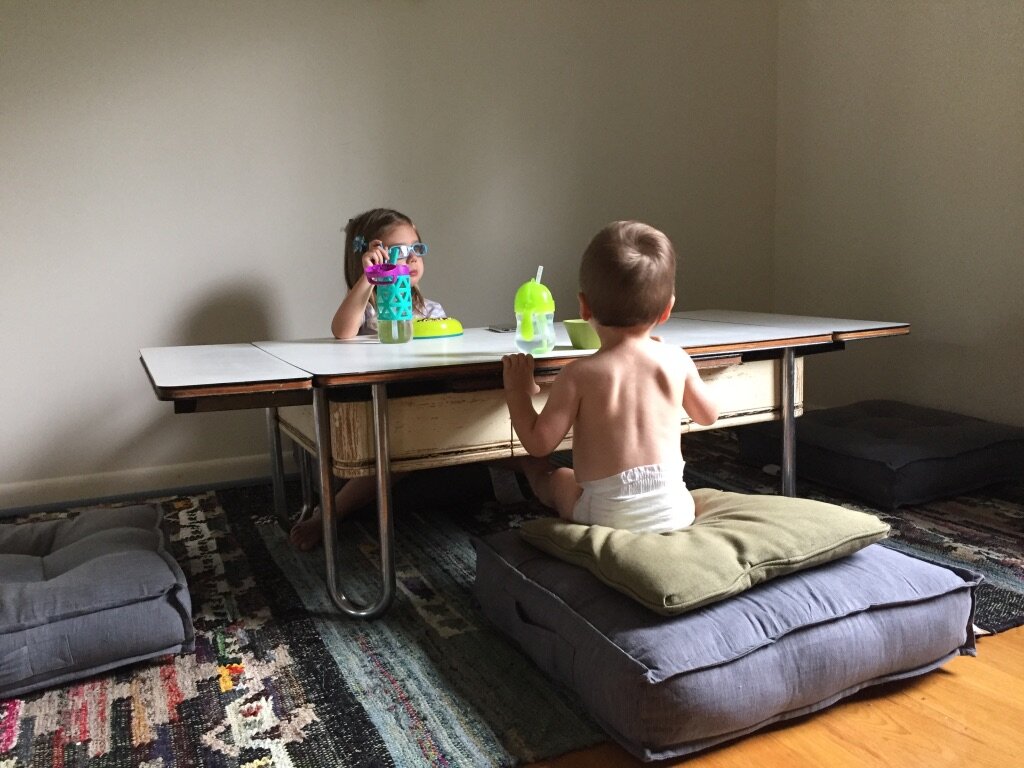Sitting - The New Fountain of Youth?
How to sit so you can live longer and move better.
Part 1 of 2
Maybe you’ve heard the phrase, “sitting is the new smoking.”
That phrase has a lot of shock value.
How could something we do every day, all day, literally be killing us?
Not to mention, what would “quitting” look like? In order to “quit,” we’d just have to stand all day long (or learn to levitate).
What if there were simple things we could do to make sitting better for us? What if we could sit in ways that are not only not harmful to our health, but actually improve our overall health and longevity?
If I told you sitting in this way could be literally the easiest, cheapest way to stay functionally strong, would you give it a try?
Because let’s face it, humans have been sitting for thousands of years. Has it always been “the new smoking?”
Nope.
I think a more accurate way to state this catchphrase would be, “sedentarism is the new smoking.”
But aren’t sitting and sedentarism the same thing?
Well, no.
Although the dictionary defines sedentary as “characterized by or requiring a sitting posture,” I argue that not all sitting is sedentary sitting.
In fact, the way of sitting I’m going to describe in this post is incredibly dynamic and opens the body to the possibility of numerous joint positions.
I’m talking about floor sitting.
Move Your Mind
We often think about movement as exercise. Exercise is something that requires special clothes, an instructor or a video, and maybe some weights or a yoga mat.
But there is a difference between movement and exercise.
Movement is just physical activity. Some movement is voluntary (like walking to the fridge for pie). Some movement is involuntary (like the beating of your heart and the movement of your intestines during digestion of said pie).
Make a mental shift away from the gym and 30 minutes of exercise a day as the way to health and toward integrating movement throughout your days to promote your health.
Floor sitting is another way of weaving health-promoting movement throughout your already established daily routines—no gym required.
You might still be wondering, “How it the world can sitting on the floor possibly be THAT good for me?”
The Benefits of Floor Sitting
Floor sitting…
Increases your moving minutes.
Provides opportunities for stretching the hips and legs.
Increases the number of your parts that are moving.
Maintains and/or increases joint mobility in the hips, knees, and ankles.
Strengthens the muscles of the legs and hips in an increased range of motion.
Promotes bone health by helping to maintain bone mass.
Maintains and/or increases functional core strength.
Requires no special equipment or dedicated time.
Now, let’s take a closer look at each of these benefits.
1. Floor sitting increases your moving minutes.
By getting down onto the floor, you’re more likely to change positions after your body tires in one. It’s unlikely that you’ll be “sitting still” for very long. As a result, you’re racking up those moving minutes and decreasing your sedentary seconds.
2. Floor sitting provides opportunities to stretch the hips and legs.
Whereas you might head to a yoga class to get a good stretch in your legs and hips, you can do the same thing at home in your sweatpants while watching Netflix and eating popcorn (or is that just me?).
Many of the joint positions the body can explore in a floor sitting posture provide a yummy stretch for our under-moved hips and legs. For some folks, simply sitting with crossed legs will feel like a hip stretch.
In this way, you can add stretching (and movement) to anything you need to do in a seated position.
Here’s a few examples from my own house:
A few years ago, my family sawed the legs of our dining table partway off to bring it closer to the floor. (It’s now about coffee table height.) We sit on comfortable floor cushions while eating meals, doing crafts, or whatever we do at the dining table.
I also was able to buy some coffee table legs off Amazon to screw onto an old IKEA table top we had lying around. Voila! Now I have a desk for my office.
©KindBody Movement, LLC
3. Floor sitting requires no special equipment or dedicated time.
So I don’t need to go to the gym or take a yoga class in order to stretch my legs and hips. I can do it while I’m eating dinner or typing up a blog post (like I am right now).
4. Floor sitting gets more of your parts moving.
Not only will you end up moving more when sitting on the floor as opposed to sitting in a chair, you’ll also be moving more of your individual parts.
Chair Shape vs. Human Shape
Think of the shape a chair puts your body in. Most chairs are the same shape so even if you sit in different kinds of chairs, your body shape will be basically the same no matter which chair you’re sitting in (unless perhaps, it’s one of those fancy ergonomic or kneeling chairs—that’s a whole different ballgame).
When you ditch the chair, your body gets to determine its own shape. This is true on the macro level, thinking about our joints and bone positions. But it’s also true on the micro level. We can also describe the difference here as active or intentional positions we take and passive or unintentional positions we take.
This big squishy chair would not really move you. You would displace the foam in the chair.
Active Shape vs. Passive Shape
Most chairs are squishy and soft. Most floors are hard. Certainly there are exceptions to each of these generalizations but suffice it to say that soft things move your body less than hard things. That’s because the soft squishy surface does the moving for you. Your body displaces that squishy surface.
Hard surfaces, however, displace or deform your body. I’m not talking about deforming in a negative sense, either. Take your bony finger and poke your squishy leg. The harder thing (your finger) deforms (leaves a dent in) in the squishier thing (your leg).
Pressure from the floor provides a mechanical input to our squishier bits and smaller joints.
Think of it this way, how does the pressure of a chair on your hamstrings effect the flow of blood and even nerve activity in the hips and legs? Spider veins anyone? We have to remember that these smaller, less noticeable parts of our bodies move and contain movement too!
Also consider how you might feel after sleeping a whole night on the floor (camping is a good illustration of this). How do you feel the next day? Is your body so used to displacing squishy surfaces that your smaller joints and movement points have atrophied and cannot be displaced incrementally by a harder surface?
©KindBody Movement, LLC
5. Floor sitting maintains and/or increases joint mobility in the hips, knees, and ankles.
As a result of the change in the hardness of your sitting surface and the removal of a prescribed body shape a chair provides, floor sitting allows you to maintain and/or increase the joint mobility of your hips, knees, and ankles.
Use it or lose it.
Oftentimes, a person will go to sit on the floor for the first time in a long while and discover that they simply can’t get there anymore—or get comfortable.
As with so many things in life, if you don’t use the mobility and ranges of motion in your floor sitting parts, you’ll lose the mobility and range of motion in your floor sitting parts. (More on comfort tips for floor sitting in my next post.)
6. Floor sitting promotes overall bone health.
So you already know that floor sitting can help you keep moving while helping you maintain healthy joints. But it also can help you maintain the health of your bones overall.
Weight-bearing exercise is essential for maintaining bone mass. Once bone mass peaks around age 30 (and it actually very nearly peaks much sooner than that, in adolescence), things can only go downhill.
Thankfully we know that weight-bearing exercise keeps the bone mass we’ve accumulated in the areas that are bearing the weight. (So for example, walking is a weight-bearing exercise. What parts of your body are bearing the weight of your body? Your feet, legs, and hips. So although walking is a weight-bearing activity, it won’t necessarily help you maintain bone mass in your arms.)
The acts of sitting down and standing up are weight-bearing movements. What parts of our body are weight-bearing during these movements? You guessed it, the feet, legs, and hips.
©KindBody Movement, LLC photo by Whitney Jade Photography
7. Floor sitting strengthens the muscles of the legs and hips in an increased range of motion.
Think about how far your body travels from standing to sitting in a chair. Depending on your height and the height of the chair, maybe your pelvis will move about a foot. Depending on the angle of your torso relative to your thighs and the amount of falling or momentum you use, different muscle groups will help you get up and down to different degrees.
Now think about how far your body travels from standing to the floor. Again, this will depend on your height, but it’s probably a whole lot farther than the distance your pelvis would travel from standing to the chair.
When moving your body down to the floor, your legs, hips, and feet are bearing the weight of your body over a longer distance, which not only strengthens your muscles across that longer range but also loads your bones in a way that helps you to maintain bone mass.
Whereas you might go to the gym and do three sets of ten squats to strengthen your legs, hips, and core while promoting overall bone maintenance, you could also just choose to sit on the floor thirty times throughout the day and potentially get similar benefits.
Kids are the best at floor sitting. Look at that functional core strength!
8. Floor sittings maintains and/or increases functional core strength.
Is floor sitting the new [insert your favorite core strength exercise here]?
Well probably not but floor sitting does require your body to self-support. Since you’ve swapped your chair back for thin air, your core musculature (and we’re not just talking abs here) instinctively activates to hold your torso upright.
It can be somewhat of a wake up call to discover that your body can’t hold itself upright for very long at all. Thankfully, there’s no exterior force making you stay in an uncomfortable or tiring position. Once your core or back get tired of holding you up in one position, you can simply change to another position.
That could even mean lounging on the floor and supporting yourself with your hands and arms. Bonus: now you’re adding weight-bearing movement to your upper body and your bones will thank you.
Although uncommon in the US, floor sitting is a common occurrence in other cultures.
Conclusion
We’ve basically established that floor sitting is the new fountain of youth.
When compared to sitting in a chair, sitting on the floor gets more of your (big and small) parts moving for more minutes. The act of getting up and down from the floor challenges your bones to maintain their density. Supporting your own frame (as opposed to a chair back doing it for you) recruits your core musculature to help keep you functionally strong. Plus, the ability to get up from the ground without using your hands or knees is a marker for longevity. The more you have to use your hands, knees, or a wall to help you get up, the more likely you are to die of all causes.
If that’s not a reason to get down with your bad self, I’m not sure what is.
I know that if you haven’t sat on the floor in a long while, it might feel uncomfortable. Never fear! My next post will include LOADS of tips and tricks to help you find your comfortable, non-sedentary seat, on the ground.













